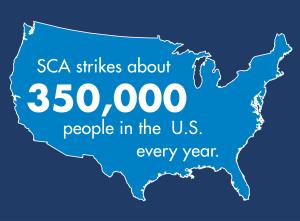Sudden Cardiac Arrest Is a Leading Cause of Death in the U.S. Each Year

October is Sudden Cardiac Awareness month. Did you know that in 2016, more than 350,000 people in the U.S. were victims of sudden cardiac arrest (SCA)? The overall survival rate was only 12%.1
Sudden Cardiac Arrest vs. Heart Attack
SCA is often confused with a heart attack, but they are actually not the same thing. During a heart attack, the blood supply to the heart muscle is suddenly blocked, resulting in the death of the heart muscle. Heart attacks are serious and can sometimes lead to SCA, but SCA may occur independently from a heart attack and without warning signs.
Cardiac arrest can happen at any time, anywhere, to anyone, and it typically comes on suddenly. The heart abruptly stops beating properly when the its electrical system malfunctions. The only effective treatment is high-quality cardiopulmonary resuscitation (CPR) and, if necessary, an electrical shock administered by an automated external defibrillator (AED).
Risk factors for SCA include:
- A family history of cardiac arrest in a first-degree relative: two-fold increase in risk of SCA2
- Underlying coronary heart disease (CHD)3
- A personal or family history of inherited disorders that make you prone to arrhythmias3 (abnormal heart rhythm)
- Heart attack3
- Heart failure3
- Commotio cordis—a term referring to SCA resulting from a blow to the chest
- Drug or alcohol abuse
CPR and AEDs in unexpected emergencies
Regardless of the cause, SCA results in death if not treated right away. The more you know about CPR and AEDs, the more you can help. Take a few simple steps so you’ll be able to help in an emergency.
- Get CPR certified
- Make note of where AEDs are located in work places, public spaces and around your community
- Learn more about the difference between SCA and a heart attack. Request a “Do you know the difference?” poster.
1“Statistical Update.” American Heart Association Website, www.cpr.heart.org/AHAECC/CPRAndECC/General/UCM_477263_Cardiac-Arrest-Statistics.jsp. Accessed 11 August 2017.
2Roger VL, et al. Executive Summary: Heart Disease and Stroke Statistics—2012 Update: A Report from the American Heart Association. Circulation. 2012;125:188-197.
3"Who is at Risk for Sudden Cardia Arrest?" National Heart, Lung and Blood Institute Website, www.nhlbi.nih.go/health/health-topics/topics/sca/atrisk. Accessed 27 September 2017.
